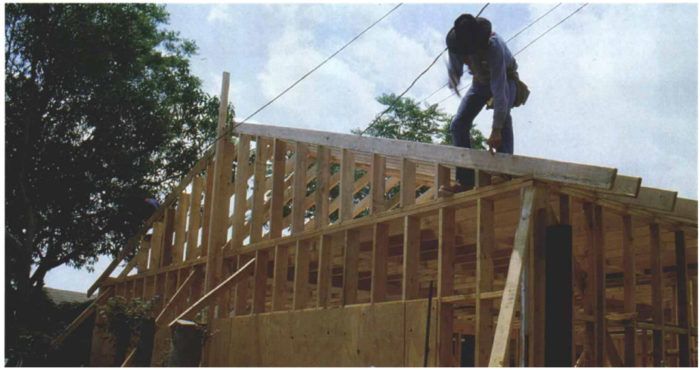Framing a Gable Roof
The secret to successful piecework, from hanging doors to framing roofs, is to break down a process into a series of simple steps.

Synopsis: Framing guru Larry Haun explains how to build a gable roof. As usual, his focus is on production methods that speed construction, such as gang-cutting the bird’s mouths with a worm-drive saw and dado. Illustrations cover the basics of this simple roof shape.
One of my earliest and fondest memories dates from the 1930s. I remember watching a carpenter laying out rafters, cutting them with a handsaw, and then over the next several days, artfully and precisely constructing a gable roof. His work had a fascinating, almost Zen-like quality to it. In a hundred imperceptible ways, the roof became an extension of the man.
But times change, and the roof that took that carpenter days to build now takes pieceworkers (craftspersons who get paid by the piece and not by the hour) a matter of hours. Since they first appeared on job sites, pieceworkers have given us new tools, ingenious new methods of construction and many efficient shortcuts. But what skilled pieceworkers haven’t done is sacrifice sound construction principles for the sake of increased production. Quite the opposite is true; they’ve developed solid construction procedures that allow them to keep up with demand, yet still construct a well-built home.
The secret to successful piecework, from hanging doors to framing roofs, is to break down a process into a series of simple steps. To demonstrate just how easy roof framing can be (with a little practice), I’ll describe how to cut and stack a gable roof the way pieceworkers do it.
The rafter horse
To begin with, pieceworkers try to avoid cutting one piece at a time. They’ll build a pair of simple horses out of 2x stock so that they can stack the rafters on edge and mark and cut them all at once. To build the rafter horses, lay four 3-ft. long 2x6s flat and nail a pair of 2x blocks onto each, with a 1-1/2in. gap between them so that you can slip in a long 2×6 or 2×8 on edge. An alternate method is to cut a notch 1-1/2 in. wide by about 4 in. deep into four scraps of 4×12. Then you can slip a long 2×6 or 2×8 on edge into these notches. Either of these horses can easily be broken down and carried from job to job. The horses hold the rafters off the ground, providing plenty of clearance for cutting.
Cutting the rafters
Rafters can be cut using a standard 7-1/4 in. sidewinder or worm-drive circular saw. This isn’t the first choice for most pieceworkers, who prefer to use more specialized tools (especially when cutting simple gable roofs). But it is the more affordable choice for most custom-home builders. If you are using a standard circular saw, load rafter stock on the horses with their crowns, or convex edges, facing up—same as the rafters will be oriented in the roof frame. Determine which end of the stack will receive the plumb cuts for the ridge and flush this end. An easy way to do this is to hold a stud against the ends and pull all the rafters up against it. Then measure down from this end on the two outside rafters in the stack and make a mark corresponding to the heel cut of the bird’s mouth (the notch in the rafter that fits over the top plate and consists of a plumb heel cut and a level seat cut). Snap a line across the tops of the rafters to connect the marks.
For more photos and information on framing a gable roof and cutting the rafters, click the View PDF button below.
Fine Homebuilding Recommended Products
Fine Homebuilding receives a commission for items purchased through links on this site, including Amazon Associates and other affiliate advertising programs.

Tajima Chalk Rite Chalk Line

Leather Tool Rig

Flashing Boot Repair


























